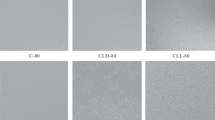Abstract
The surface morphology and supramolecular structure of chitosan-based hollow cylindrical structures (microtubes) obtained by wet and dry–wet spinning were studied with the use of salting-out agents of various chemical nature by scanning electron microscopy. All samples are characterized by a layer-oriented porous structure, whose morphological features are determined by the spinning process and the chemical nature of the reagent for the polymer conversion polysalt → polybase reaction. An explanation of the formation of this layered structure is proposed within the framework of the Liesegang phenomenon. The influence of the nature of the salting-out agent on the mechanism of the chemical reaction and the polymer material structure was assessed. All microtube samples are shown to be characterized by anisotropy of their mechanical properties. When stretching in the longitudinal direction, an almost linear load–strain relationship is observed with the elastic component predominance, while stretching in the transverse direction yields a nonlinear one with the predominance of plastic deformation.







Similar content being viewed by others
References
Sher, P., Custódio, C. A., & Mano, J. F. (2010). Layer-by-layer technique for producing porous nanostructured 3D constructs using moldable freeform assembly of spherical templates. Small, 23, 2644–2648.
Nie, J., Lu, W., Ma, J., Yang, L., Wang, Z., Qin, A., & Hu, Q. (2015). Orientation in multi-layer chitosan hydrogel: morphology, mechanism, and design principle. Scientific Reports. doi:10.1038/srep07635.
Haque, M. A., & Gong, J. P. (2013). Multi-functions of hydrogel with bilayer-based lamellar structure. Reactive and Functional Polymers, 73, 929–935.
Wang, Z., Hu, Q., & Ca, L. (2010). Сhitin fiber and chitosan 3D composite rods. International Journal of Polymer Science. doi:10.1155/2010/369759.
Kim, I. Y., Seo, S. J., Moon, H. S., Yoo, M. K., Park, I. Y., Kim, B. C., & Cho, C. S. (2008). Chitosan and its derivatives for tissue engineering applications. Biotechnology Advances, 26, 1–21.
Gnavi, S., Barwig, C., Freier, T., Haastert-Talini, K., Grothe, C., & Geuna, S. (2013). The use of chitosan-based scaffolds to enhance regeneration in the nervous system. International Review of Neurobiology, 109, 1–62.
Tanaka, N., Matsumoto, I., Suzuki, M., Kaneko, M., Nitta, K., Seguchi, R., & Takemura, H. (2015). Chitosan tubes can restore the function of resected phrenic nerves. Interactive Cardiovascular and Thoracic Surgery, 21, 8–13.
Gegel NO, Shipovskaya AB, Vdovykh LS, Babicheva TS (2014) Preparation and properties of 3D chitosan microtubes. Journal Soft Matter, 9.
Rinaudo, M., Pavlov, G., & Desbrieres, J. (1999). Influence of acetic acid concentration on the solubilization of chitosan. Polymer, 40, 7029–7032.
Gegel, N. O., Babicheva, T. S., & Shipovskaya, A. B. (2015). Peculiarities of making chitosan microtubes by interfacial polymer conversion reaction. Butler Commun, 41, 44–53.
Kildeeva, N. R., Babak, V. G., Vichoreva, G. A., Ageev, E. P., et al. (2000). A new approach to the development of materials with controlled release of the drug substance. Herald of Moscow University. Series 2. Chemistry (in Rus), 41, 423–425.
Babicheva, T. S., Gegel, N. O., & Shipovskaya, A. B. (2015). Influence of the salting-out agent nature on the strength properties of chitosan microtubes. Journal of Nature Science and Sustainable Technology (JNSST), 9, 31–42.
Molnar, F., Izsák, F., & Lagzi, I. (2008). Design of equidistant and revert type precipitation patterns in reaction-diffusion systems. Physical Chemistry Chemical Physics, 10, 2368–2373.
Stone, D. A., & Goldstein, R. E. (2004). Tubular precipitation and redox gradients on a bubbling template. Proceedings of the National Academy of Sciences of the United States of America, 101, 11537–11541.
Làrez, V. C., Crescenzi, V., Dentini, M., & Ciferri, A. (1995). Assemblies of amphiphilic compounds over rigid polymers: 2. Interaction of sodium dodecylbenzenesulfonate with chitosan-scleraldehyde gels. Supramolecular Science, 2, 141–147.
Chitin and chitosan. Ed. Skriabin KG, Vikhoreva GA, Varlamov VP (2002) Moscow: Nauka. 211–216.
Rinaudo M, Kildeyeva NR, Babak VG (2008) Surfactant-polyelectrolyte complexes based on chitin derivatives. Russ. Chem. J. LII: 84-90.
Acknowledgements
This work was supported by the Russian Foundation for Basic Research, project no. 16-33-00953 “Scientific fundamentals of the preparation of 3D biodegradable structures from natural polysaccharides to create blood vessel analogs.”
Author information
Authors and Affiliations
Corresponding author
Ethics declarations
Conflict of Interest
The authors declare that there is no conflict of interest regarding the publication of this paper.
Rights and permissions
About this article
Cite this article
Gegel, N., Babicheva, T. & Shipovskaya, A. Morphology of Chitosan-Based Hollow Cylindrical Materials with a Layered Structure. BioNanoSci. 8, 661–667 (2018). https://doi.org/10.1007/s12668-017-0415-1
Published:
Issue Date:
DOI: https://doi.org/10.1007/s12668-017-0415-1




